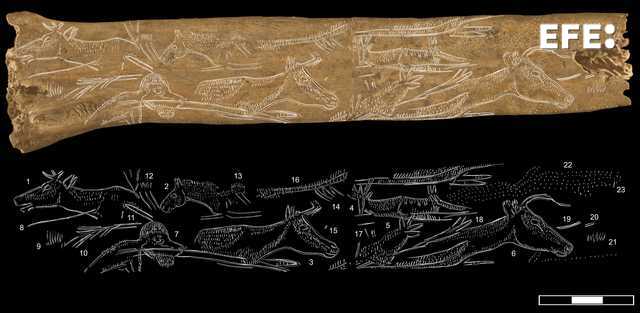Carlos López left/San Sebastián (EFE).- A collection of prehistoric fauna in a gannet bone decorated 12,000 years ago. Deer, horses, goats, aurochs and chamois, a whole lesson in prehistoric fauna, gathered in a small bird bone.
fauna collection
An alcatraz ulna on which an artist carved some 12,000 years ago also other symbols, several of which have now been discovered thanks to the restudy of the piece, originally discovered in 1966.

As reported by the University of the Basque Country (UPV/EHU) in a note, the finding, published in the Journal of Paleolithic Archaeology, corresponds to research based on the doctoral thesis of archaeologist Asier Erostarbe.
The piece, 17.9 centimeters long, located in the La Torre de Oiartzun cave (Gipuzkoa), is one of the few furniture objects of art with a pericylindrical decoration from the peninsula that presents a complex combination of motifs around its contour.
gannet bone
The bone is profusely decorated with figurative representations of animals. Among them an anthropomorph, and different signs such as simple, parallel lines and zigzags, several of which did not appear in the first inspection that the anthropologist José Miguel Barandiarán made of the object, but which have now come to light thanks to new technologies, as EFE Asier Erostarbe has now explained.
The figurative engravings, arranged in two bands facing inversely, demonstrate the great “expertise” of the Magdalenian artist who made them along the entire cylinder of the gannet bone. A piece that brings together some of the favorite hunting animals in prehistory, such as the deer or the mountain goat, but also others that were less frequently hunted such as the horse, the aurochs or the chamois.
similar pattern
The analysis carried out by Erostarbe now shows that the representations “follow a similar pattern in all cases”. The outlines of the figures and signs were first traced by running a stone tool, possibly a burin, several times to make deep grooves.

The decorations formed by short lines and notches were made later. Sometimes it was necessary for the engraver to turn the bone over to practice them.
The Erostarbe study also confirms that the artist had “great cognitive capacity, an aesthetic appreciation of visual regularity and a lateralization of motor functions”.
Magdalenian sites
The figures made also present “similarities in the treatment”, especially of the animals, with other Magdalenian sites on the Cantabrian coast and the Pyrenees. This would corroborate “exchanges of technical and iconographic behaviors” between different artists.
At the moment, the function of this type of cylindrical object is unknown, to which different uses are attributed such as airbrushes, whistles, needle containers, beads in the manufacturing process, ocher containers or even ritual objects.
“Having a small set of specimens in the world, it is very difficult to attribute a single functionality and they may have served as multifunctional objects,” concludes the note from the UPV/EHU. EFE






